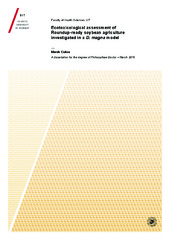Ecotoxicological assessment of Roundup-ready soybean agriculture investigated in a D. magna model
Permanent lenke
https://hdl.handle.net/10037/7869Åpne
Thesis introduction (PDF)
Marek Cuhra, Terje Traavik, Thomas Bøhn. 2013. Clone- and age-dependent toxicity of a glyphosate commercial formulation and its active ingredient in Daphnia magna. Ecotoxicology 22: 251:262 (doi:10.1007/s10646-012-1021-1) (PDF)
T. Bøhn, M. Cuhra, T. Traavik, M. Sanden, J. Fagan, R. Primicerio. 2014. Compositional differences in soybeans on the market: glyphosate accumulates in Roundup Ready GM soybeans. Food Chemistry, 153: 207-215 (doi:10.1016/j.foodchem.2013.12.054) (PDF)
Marek Cuhra, Mickaël Dando, Terje Traavik, Raul Primicerio, Daniel Holderbaum, Thomas Bøhn. 2015. Glyphosate‐Residues in Roundup‐Ready Soybean Impair Daphnia magna Life-Cycle. Journal of Agricultural Chemistry and Environment, 4, 24‐36. (doi: 10.4236/jacen.2015.41003) (PDF)
Marek Cuhra. 2015. Analysis of herbicide‐residues is essentially missing in risk‐assessment of herbicide-tolerant genetically modified cultivars. (manuscript version) (PDF)
Dato
2015-06-09Type
Doctoral thesisDoktorgradsavhandling
Forfatter
Cuhra, MarekSammendrag
Transgenic glyphosate tolerant soybeans are constituents of an industrial production system with specific agricultural practices and supplementary agrochemicals as interwoven additional elements. Thus the material produced should not be seen as an isolated product of a specific modified genotype but rather as a product of a tailored agriculture system.
This globally dominant crop has been in open cultivation since 1995 and is still predominantly based on hybrid varieties of the GTS-40-3-2 transgenic event soybean (Roundup-ready soybean) in combination with glyphosate herbicide co-technology.
The herbicides were tested for acute and chronic toxicity in a D. magna animal model. It was found that the ecotoxicity is more potent than what was previously assumed in regulatory assessments based on information provided by chemical industry. Notably, it was found that low concentrations of Roundup induce reproductive failure in D. magna (paper I).
Laboratory analysis show systematic differences which characterize these products. Substantial ppm-levels of glyphosate residues were found to be systematically present in all tested samples of Roundup-ready soybean (paper II).
Life-long feeding-study with soybean-feed in D. magna demonstrated that overall animal performance measured as growth and reproduction was significantly affected by soy-meal diets. Animals fed transgenic soybean-meal showed significantly reduced growth and reproduction (paper III).
The research presented in papers II, II and IV contributes to a body of evidence indicating that directly and indirectly measurable material differences between transgenic and conventional cultivars are significant qualitative aspects, which challenge the concept of substantial equivalence. The traditional methodology for testing whether transgenic plants are substantially equivalent to their unmodified origins should be adjusted based on these findings.
Finding that exposure to low-levels of glyphosate or Roundup in the environment will impair D. magna growth and reproduction, indicates that the negative effects seen in feeding-studies could be caused by toxic effects from glyphosate residues.
Beskrivelse
Paper III of this thesis is not available i Munin:
III: M. Cuhra, T. Traavik & T. Bøhn. 2014. 'Life cycle fitness differences in Daphnia magna fed Roundup-Ready soybean or conventional soybean or organic soybean', available in Aquaculture Nutrition
III: M. Cuhra, T. Traavik & T. Bøhn. 2014. 'Life cycle fitness differences in Daphnia magna fed Roundup-Ready soybean or conventional soybean or organic soybean', available in Aquaculture Nutrition
Forlag
UiT The Arctic University of NorwayUiT Norges arktiske universitet
Metadata
Vis full innførselSamlinger
Copyright 2015 The Author(s)
Følgende lisensfil er knyttet til denne innførselen:


 English
English norsk
norsk
